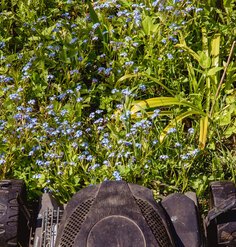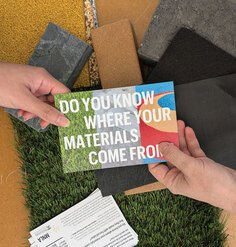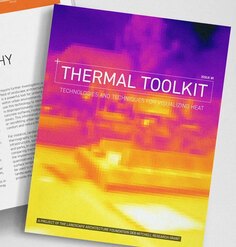Understanding Roadside Air Pollution: OJB Builds on LAF-Funded Research to Improve Public Health
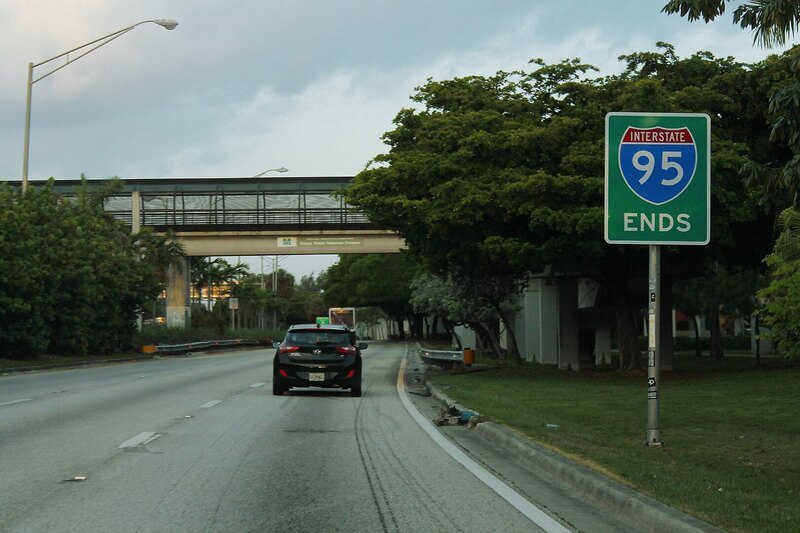
In 2020, the Landscape Architecture Foundation awarded the first Research Grant in Honor of Deb Mitchell to “Greenscapes to Brownscapes: A Study on Impacts to Contaminant Levels in Landscapes Adjacent to Highways.” Four years later, the impact of this work continues to grow. We recently spoke to one of the grant’s Principal Investigators, Allison Harvey (Principal, OJB), to learn how the project lives on.
The 2020-2021 “Greenscapes to Brownscapes” project examined traffic-related air pollution along major roadways. Specifically, the team—led by Principal Investigators Allison Harvey (OJB) and environmental chemist Andrew Adams (IKON Environmental Solutions)—assessed pollutant levels along a stretch of the I-95 corridor in Philadelphia. They aimed to develop and test a repeatable method for assessing pollutants from roadways in order to evaluate the varying effectiveness of vegetative and built barriers or screens for communities living and working next to these roads.
Following these tests, they conducted a series of engagement sessions with experts across various disciplines on strategies for improving human health, wellness, and happiness in landscapes affected by polluted air. You can read more about their methods and results in the grant project's final report.
This initial research also highlighted the ways in which landscape architects are well-positioned to address highway pollution through research, advocacy, and design. “Roadside landscapes may not seem like the sexiest frontier to be designing for,” says Allison, “but they represent a lot of land across the country. We're talking about millions of miles of roadway. In the urban environment, roadside landscapes can account for 25% of the public land.”
The health impacts of exposure to these roadsides are no trivial matter, something the research team made clear in the “Greenscapes to Brownscapes” report:
“The Health Effects Institute considers exposure within 300-500 meters of a road to be a health concern. Over 45 million people in the US live, work or attend school within 300 feet of a major road, airport or railroad. There is evidence linking [Exposure to Traffic Related Air Pollutants] to a suite of outcomes including stroke, COPD, cancer, birth defects, low birth weight, delayed childhood cognitive development, autism, Parkinson’s disease, and Alzheimer’s disease. Nearly 4.2 million deaths worldwide are related to exposure to outdoor air pollution. In the United States, 84% of counties exhibit a racial disparity, where Black and Hispanic [populations] are over-represented in living within 500 meters of highways.”
The data may be grim, but the sheer volume of land and room for air quality improvement means that simple, effective, implementable strategies can actually have significant positive impacts on the health and wellness of people and the environment. Getting landscape architects and urban planners engaged with the issue is key. Air quality is a hidden issue in landscape architecture, Allison says. It’s not being measured and taken into consideration at the frequency and scale needed. She wants to expand the conversation around air pollution and green infrastructure and contribute to a transdisciplinary approach to this critical issue. There is a lot of potential here, and Allison and her colleagues at OJB are eager to keep growing the conversations, knowledge base, and coalitions.
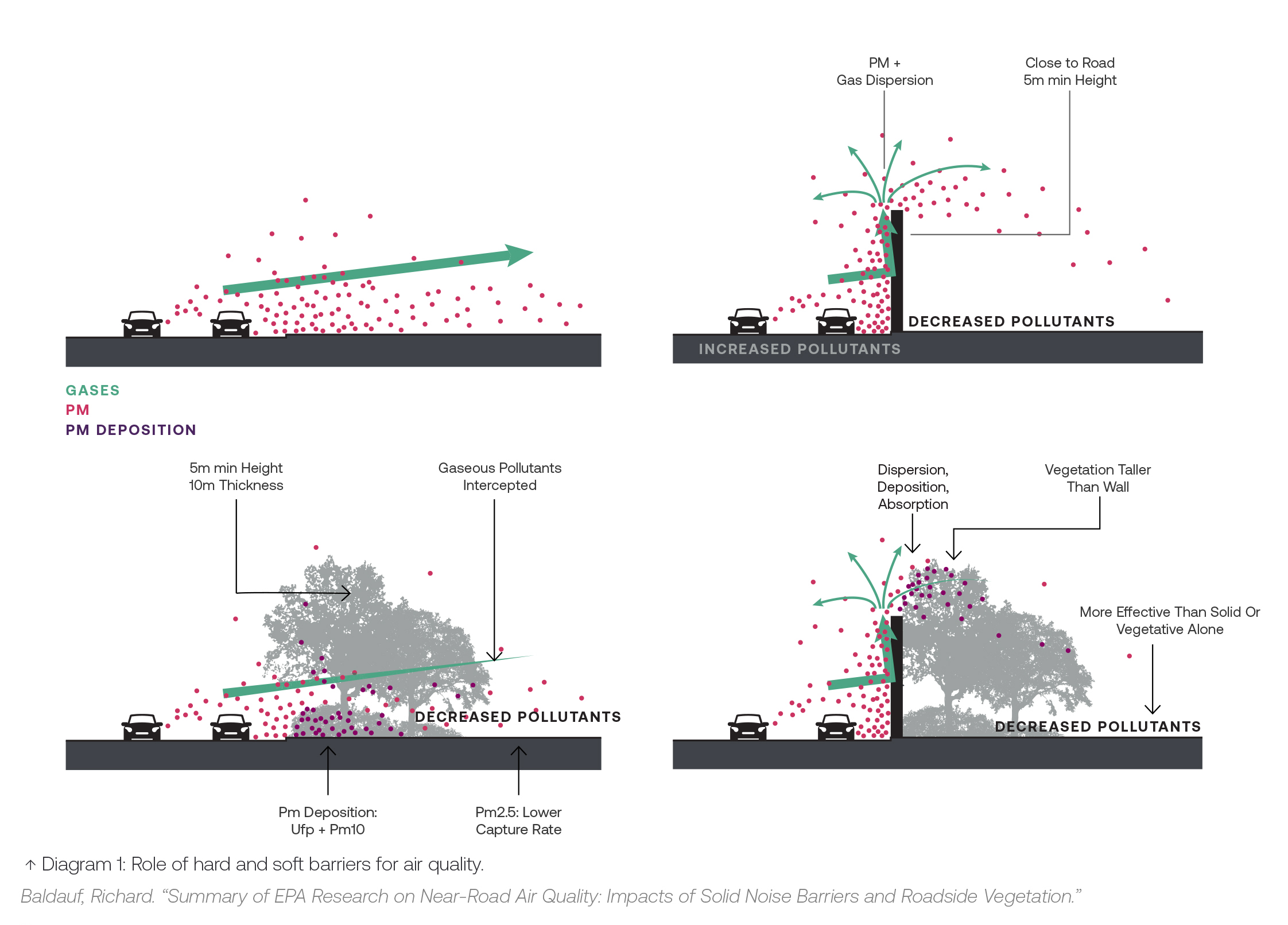
It's now been several years since the LAF grant-funded report was released, Allison and OJB have continued to build on the “Greenscapes to Brownscapes” project. They have presented their research at conferences like Greenbuild, to research groups like the Transportation Research Board, and to local government and community groups interested in improving their air quality. Out of these presentations and conversations, they’ve identified the need for—and begun work on—visualization tools based on existing scientific research. These visualizations could help policy makers and advocates identify possible interventions, model solutions, and advocate for funding and implementation. OJB is also working on site specific actions, like partnering with a public school district in the Midwest to envision landscape interventions that improve air quality for their students.
One regional group taking this issue seriously is the Lehigh Valley Planning Commission. This eastern Pennsylvania region had been doing their own investigations into options for reducubg highway pollution and reversing declining air quality in the Lehigh Valley. They worked with the EPA to develop the Valley’s first ever climate action plan and envisioned their 500+ acres of roadside green spaces as an opportunity to not only improve their air quality, but also make driving through their region a more pleasant and calming experience. When they heard about OJB’s air pollution work, the LVPC was already in the process of applying for a $115 million EPA Green Infrastructure grant to implement their vision of roadways that are healthy for people, pollinators, and plants.
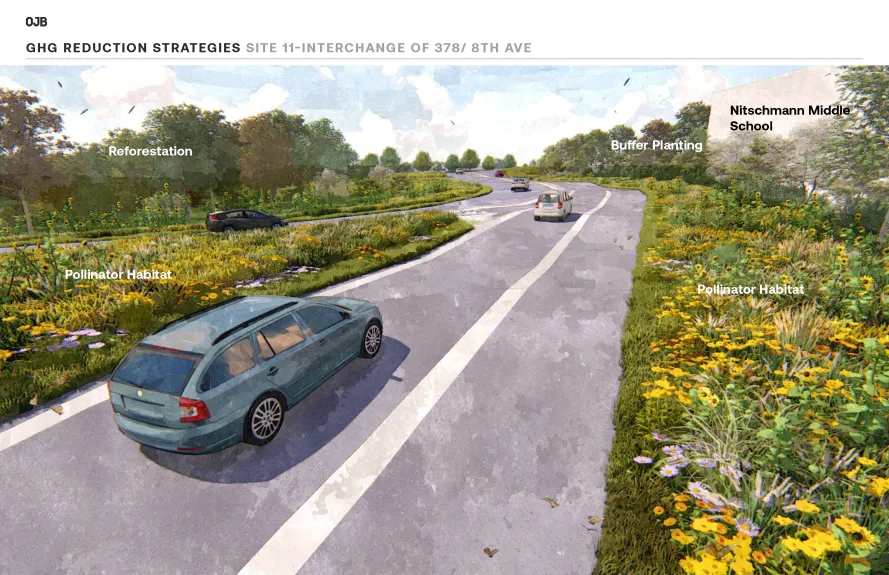
The LVPC’s Executive Director, Becky Bradley, was introduced to OJB's Allison Harvey through mutual connections at The University of Pennsylvania Stuart Weitzman School of Design, and OJB soon started working with the LVPC to support their application. They assisted in developing a strategy for that grant application as well as air quality calculations and the visualizations needed to share plans with the wider community. As of this article’s publication in August 2024, the application has been submitted and the LVPC is working to garner community support to improve their chances.
If you’d like to learn more about the Lehigh Valley project and OJB’s involvement, Allison and LVPC staff members were recently on NPR affiliate WDIY to explain their goals and how the grant would be used. The project was also featured in The Morning Call, a regional paper, in early 2024.
The LAF Research Grant in Honor of Deb Mitchell was established in 2020 to raise the profile of research within landscape architecture and offer new opportunities for collaborative research. The “Greenscapes to Brownscapes” project—the first recipient of the grant—has been a great example of the potential impact landscape architecture can have in the world.
Reflecting on how the grant has impacted her personally, Allison says it’s put her career on a whole new trajectory, one that’s focused on innovation. “It really opened up a community to me, as a professional, where I found a lot of other people battling these really large issues within our industry.”
Addressing air pollution and harnessing the potential of these roadside spaces is a long game, Allison says, and change is going to be incremental. But each step along the way is meaningful, and she’s excited to see where this research and these collaborations go in the future.
Applications for the 2025 Research Grant in Honor of Deb Mitchell are due by Dec 1, 2024. To stay up to date on news about LAF's research programs as well as our other programs, events, and funding opportunities, subscribe to LAF emails.

